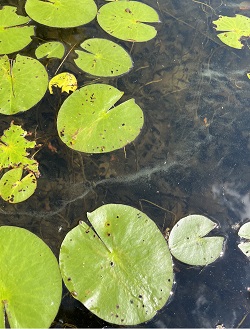Cyanobacteria
Contact
State Issues Cyanobacteria Bloom Advisory for Lake Kanasatka in Moultonborough, NH
Concord, NH - A cyanobacteria bloom has been observed on Lake Kanasatka. The bloom is appearing as wispy aggregations of light green specks. This surface aggregation was first observed on 7/29/22 and has been seen in several locations across the lake. Surface accumulations may quickly move around the lake, accumulating in different areas. Samples collected and reviewed on 7/29/22 revealed cyanobacteria (Dolichospermum) in concentrations up to 109,267 cells/mL in areas of highest observed accumulations. Advisories are issued when cyanobacteria cell concentrations exceed 70,000 cells/mL. As a result, NHDES has issued a cyanobacteria bloom advisory for those who use the waterbody for recreation. The advisory is not based on a toxin evaluation and is intended as a precautionary measure for short term exposure. Additional samples reviewed today, and earlier this week had other cyanobacteria (Anabaena, Tolypothrix, and Calothrix) present in low densities from shoreline samples. These cyanobacteria are more typically found along shorelines and associated with benthic growth and do not form surface blooms, but can produce toxins and should be avoided.
 Surface blooms can rapidly change and accumulate in different locations around a waterbody. Please continue to monitor your individual shorelines for changing conditions. NHDES advises lake users to avoid contact with the water in areas experiencing elevated cyanobacteria cell conditions, also known as a bloom. NHDES also advises pet owners to keep their pets out of any waters that have a cyanobacteria bloom.
Surface blooms can rapidly change and accumulate in different locations around a waterbody. Please continue to monitor your individual shorelines for changing conditions. NHDES advises lake users to avoid contact with the water in areas experiencing elevated cyanobacteria cell conditions, also known as a bloom. NHDES also advises pet owners to keep their pets out of any waters that have a cyanobacteria bloom.
Cyanobacteria are natural components of water bodies worldwide, though blooms and surface scums may form when excess nutrients are available to the water. Some cyanobacteria produce toxins that are stored within the cells and released upon cell death. Toxins can cause both acute and chronic health effects that range in severity. Acute health effects include irritation of skin and mucous membranes, tingling, numbness, nausea, vomiting, seizures and diarrhea. Chronic effects may include liver and central nervous system damage. Be cautious of lake water that has a surface scum, changes colors, or appears to have green streaks or blue-green flecks aggregating along the shore.
The cyanobacteria advisory went into effect on July 29, 2022, and will remain in effect until NHDES confirms that cell concentrations of the bloom have subsided.
- Visit the NHDES Beach Program website for photos and more information about cyanobacteria at Harmful Algal Blooms.
- Updates on cyanobacteria advisories may be obtained on the Beach Advisory Mapper.
- Follow the Beaches twitter feed.
If you notice anything resembling cyanobacteria, please refrain from wading, swimming or drinking the water. Keep all pets out of the water and contact NHDES immediately. Please call NHDES to report a cyanobacteria bloom at (603) 848-8094 or email HAB@des.nh.gov.




